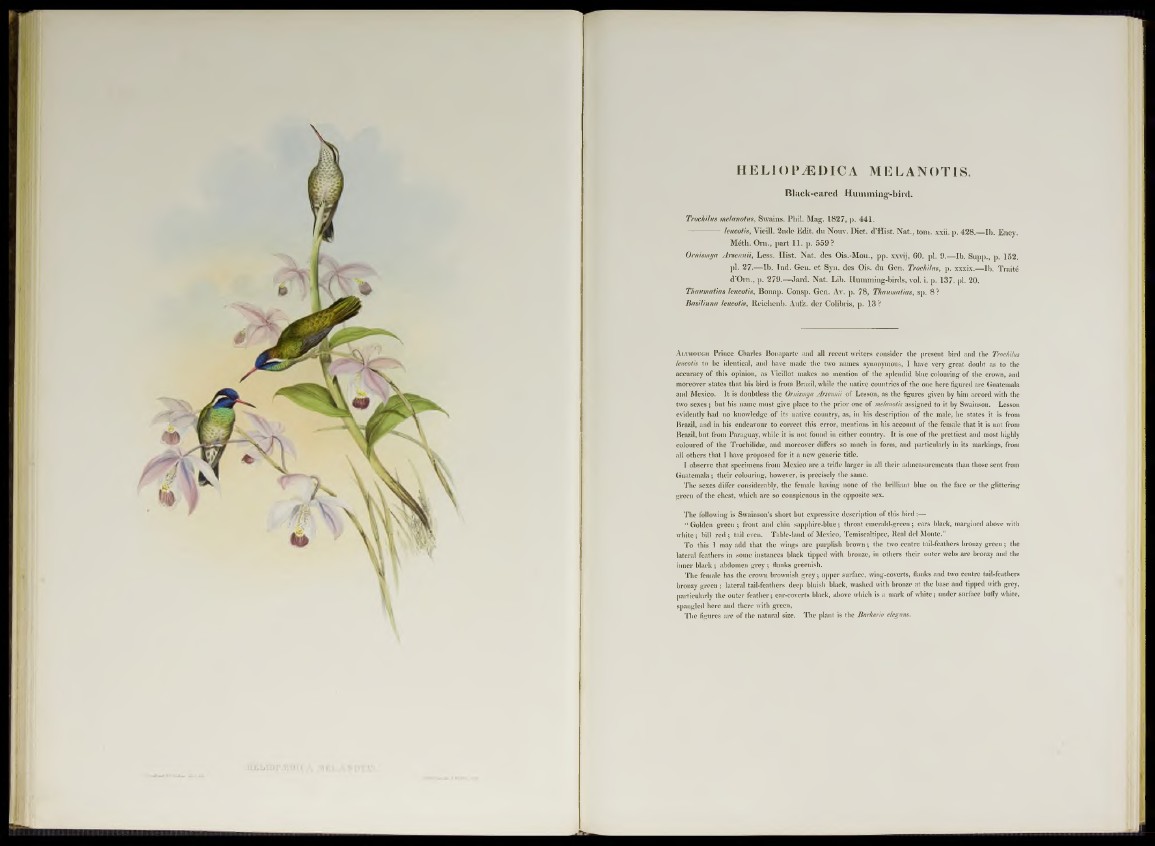
HELIOPJEDICA MELANOTIS .
Black-eared Humming'-bird.
Trochilm melanotus, Swains. Phil. Mag. 1827, p. 441.
— leucotis, Vieill. 2nde Edit. du Nouv. Dict. d’Hist. N at., tom. xxii. p. 428.—Ib. Ency.
Méth. Om., part 11. p. 559?
Ornismya Arsennii, Less. Ilist. Nat. des Oïs.-Mou., pp. xxvij, 60. pl. 9.—Ib. Supp., p. 152.
pl. 27.—Ib. Ind. Gen. et Syn. des Ois. du Gen. Trochilm, p. xxxix.— Ib. Traité
d’Orn., p. 279.—Jard. Nat. Lib. Humming-birds, vol. i. p. 137. pl. 20.
Thaumatias leucotis, Bonap. Consp. Gen. Av. p. 78, Thaumatias, sp. 8 ?
Basilinna leucotis, Reichenb. Aufz. der Colibris, p. 13 ?
Although Prince Charles Bonaparte and all recent writers consider the present bird and the Trochilus
leucotis to be identical, and have made the two names synonymous, I have very great doubt as to the
accuracy of this opinion, as Vieillot makes no mention of the splendid blue colouring of the crovvn, and
moreover States that his bird is from Brazil, while the native countries of the one here figured are Guatemala
and Mexico. It is doubtless the Ornismya Arsennii of Lesson, as the figures given by him accord with the
two sexes; but his name must give place to the prior one of melanotis assigned to it by Swainson. Lesson
evidently had no knowledge of its native country, as, in his description of the male, he States it is from
Brazil, and in his endeavour to correct this error, mentions in his account of the female that it is not from
Brazil, but from Paraguay, while it is not found in either country. It is one of the prettiest and most highly
coloured of the Trochilidae, and moreover differs so much in form, and particularly in its markings, from
all others that I have proposed for it a new generic title.
I observe that specimens from Mexico are a trifle larger in all their admeasurements than those sent from
Guatemala; their colouring, however, is precisely the same.
The sexes differ considerably, the female having none of the brilliant blue on the face or the glittering
green of the chest, which are so conspicuous in the opposite sex.
The following is Swainson’s short but expressive description of this bird :—
“ Golden green ; front and chin sapphire-blue; throat emerald-green; ears black, margined above with
white; bill red ; tail even. Table-land of Mexico, Temiscaltipec, Real del Monte.”
To this I may add that the wings are purplish brown; the two centre tail-feathers bronzy green; the
lateral feathers in some instances black tipped with bronze, in others their outer webs are bronzy and the
inner black ; abdomen grey ; flanks greenish.
The female has the crown brownish grey; upper surface, wing-coverts, flanks and two centre tail-feathers
bronzy green; lateral tail-feathers deep bluish black, washed with bronze at the base and tipped with grey,
particularly the outer feather; ear-coverts black, above which is a mark of white; under surface buffy white,
spangled here and there with green,
The figures are of the natural size. The plant is the Barkeria elegans.